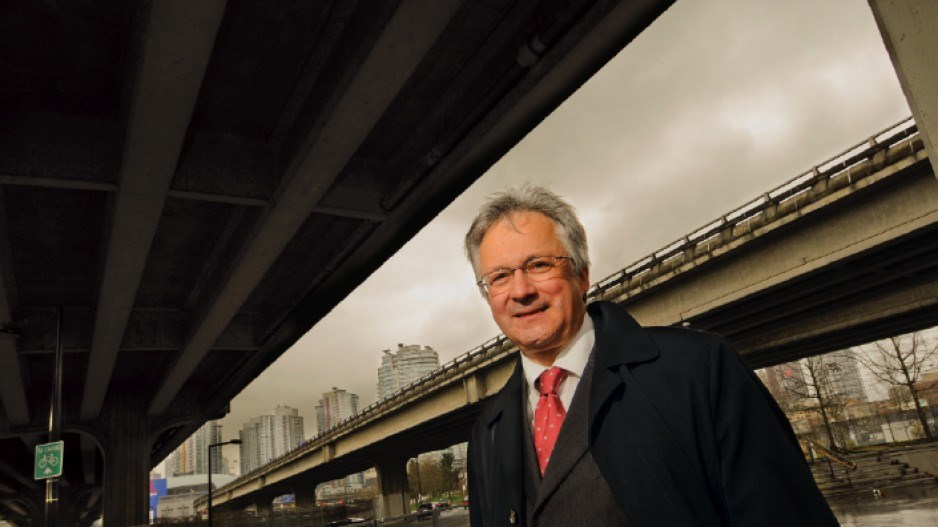The City of Vancouver's plan to replace the Georgia and Dunsmuir Street viaducts has business groups intrigued but still urging caution and more study to ensure the new design won't generate traffic chaos.
"At the end of the day it's all about access into and out of the downtown," Charles Gauthier, president and CEO of the Downtown Vancouver Business Improvement Association (DVBIA), told Business in Vancouver.
On June 26 council voted to spend $2.4 million to continue working on consultation and logistics for the project. A final vote on whether to remove the viaducts is not expected until June 2015.
According to the proposal both viaducts would be removed and Georgia Street would connect with a remodelled Pacific Boulevard via a ramp. Pacific Boulevard would be pushed north and combined with Expo Boulevard to run under and alongside the SkyTrain track.
The new four-lane stretch of Pacific Boulevard would have five intersections, at Main, Quebec, Carrall, Abbott and Georgia streets. The viaducts currently handle a combined five lanes of traffic.
Dunsmuir Street would end in a cul-de-sac.
The new street configuration was first unveiled in the summer of 2012; the idea came out of a 2011 design competition. After studying traffic data for the past two years, Jerry Dobrovolny, the city's director of transportation, says it's now possible to consider instituting the plan by 2017.
A 2010 study estimated that it would be 15 to 20 years before vehicle volumes would drop enough to allow the viaducts to be removed without increasing traffic congestion.
Along with the new road design, other factors in the city's analysis include:
•a 20% drop in vehicles entering and leaving downtown in the past 15 years;
•an expectation that the Evergreen Line will further reduce the number of cars; and
•lessons learned from a temporary closure of the viaducts during the 2010 Winter Olympics.
Dobrovolny said the new design will make it easier to get into downtown.
"The way it is today, you have that escarpment that runs along the hockey arena and BC Place," he said. "You've got limited availability to move up and into the downtown."
In a July 2012 letter to Vancouver city council, the Vancouver Board of Trade (VBOT) called the Pacific Boulevard redesign "practical and efficient."
In an updated message sent to the city last week, the VBOT said it supports the plan as long as "the infrastructure which replaces the viaducts provides sufficient capacity for the projected volumes of traffic and goods movement, while respecting the needs of residential and business neighbourhoods."
"[There is] still a lot more work to be done before a decision can be made," wrote Rob MacKay Dunn, director of public policy for the VBOT, in an email to BIV.
The new road design has also satisfied truckers, according to the BC Trucking Association (BCTA).
"Surprisingly … we haven't had any concerns raised by our members," said BCTA president Louise Yako, who noted that the current route is used mostly by smaller trucks and vans.
"Our main concern is that there would continue to be a route there that wouldn't displace commercial vehicles."
Gauthier said his members still have questions about how traffic would circulate within the downtown core, because more traffic would flow onto Georgia Street and less would use Dunsmuir Street.
"Dunsmuir Street's still there, but it's going to be a little bit of a challenge for people coming off the new West Georgia Street," he said. "They're going to have to make a right-hand turn on a northbound street and make a left-hand turn on Dunsmuir and then make a left-hand turn on southbound streets.
"You're going to be adding to the travel time and – I use the word at my risk here – you're creating more of a maze." •
The new Pacific Boulevard nitty-gritty
Construction on the new Pacific Boulevard is planned to begin in 2017, after two years of parking and street design. The road construction is expected to take 18 months.
The city plans to build the replacement road before viaduct demolition begins. But city staff anticipate "a four-month window" during construction, when the Georgia Street ramp to connect to Pacific Boulevard will be built, and drivers will lose a direct connection to downtown.
Estimated cost of the street portion of the project:
•$50 million to $55 million to remove the viaducts; and
•$30 million to $35 million to change existing streets and utilities.
According to the city, keeping the viaducts will cost $35 million to $40 million in the next five to 15 years and an additional $60 million to $80 million in about 40 years, when they will need to be replaced.




